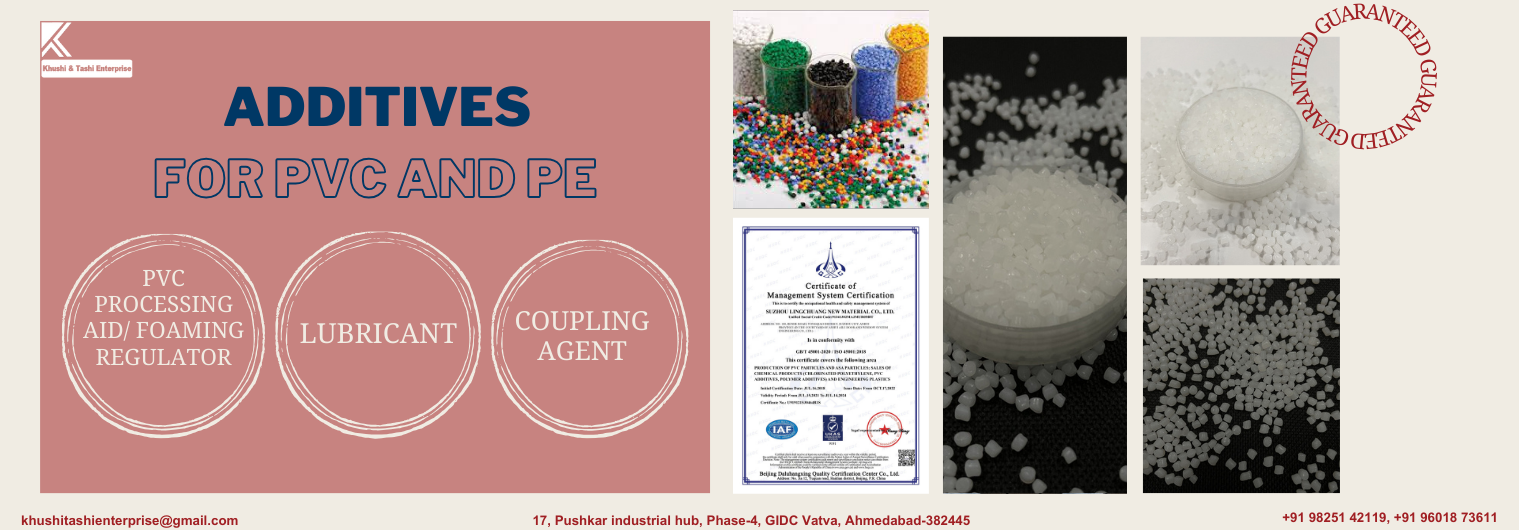Additives

Khushi and Tashi Enterprise keeps stock of PVC processing aid or foaming regulator, lubricants and coupling agent or compatibliser for PE and PP.
1. Foaming regulator
Foaming regulators are typically used in the production of foamed PVC products, which have a variety of applications, including in the construction, automotive, and packaging industries. The advantages of the same are as below.
Density Control: Foaming regulators are added to the PVC formulation to control the density of the final foamed product. By adjusting the amount of foaming regulator, manufacturers can achieve the desired level of foam expansion and, consequently, the density of the foamed PVC. This is important because the density affects the mechanical and thermal properties of the material
Weight Reduction: By incorporating foaming agents and foaming regulators, the density of PVC can be reduced significantly, which leads to weight reduction in the final product.
Enhanced Processability: Foaming regulators can improve the processing characteristics of PVC during extrusion and molding. They can help reduce melt viscosity, promote uniform expansion, and prevent issues like surface defects in foamed PVC products.
Usage: PVC-WPC foam board, WPC door frame, WPC door, PVC-WPC wall panel and decorative panels.
Commercial grades: HK901,HK921, ACR401, LP92
2. Coupling Agent
A compatibilizer or coupling agent for Wood-Plastic Composites (WPC) is a chemical additive that plays a crucial role in enhancing the compatibility and interaction between the wood fibres or flour and the thermoplastic polymer matrix in WPE materials.
It improves Bonding, Compatibilizers are added to WPC formulations to promote strong interfacial adhesion between the wood component and the polymer component. This results in better bonding and compatibility between the two materials, which is vital for the overall performance and durability of the WPC.
It enhances Mechanical Properties: The addition of coupling agents can lead to improved mechanical properties of the WPC, such as increased tensile strength, flexural strength, and impact resistance. This is essential for applications where structural integrity is important, such as outdoor decking and WPE panels.
It is water Resistant: Wood fibres or flour in WPC can be susceptible to moisture absorption, which can lead to swelling and degradation. Coupling agents help reduce water absorption by creating a hydrophobic barrier, making the WPC more resistant to moisture-related issues.
3. Lubricants
A lubricant for Wood-Plastic Composites (WPC) serves as an essential additive designed to reduce friction, improve processing, and enhance the overall performance of the WPC material. Here’s an explanation of the use of lubricants in WPC production:
Reduced Friction: Lubricants are added to WPC formulations to reduce the friction and resistance between the wood fibers or flour and the thermoplastic polymer matrix. This reduction in friction aids in the processing of WPC materials and helps prevent wear and tear on processing equipment, such as extruders and molds.
Improved Processability: Lubricants enhance the melt flow and processability of WPC during extrusion, injection molding, and other manufacturing processes. This results in more efficient production, reduced energy consumption, and better dimensional stability of the final WPC product.
Enhanced Surface Finish: Lubricants can contribute to a smoother surface finish of WPC products, which is important for applications where aesthetics and tactile quality matter, such as decking, fencing, or furniture.
